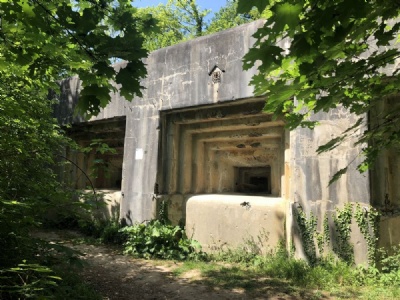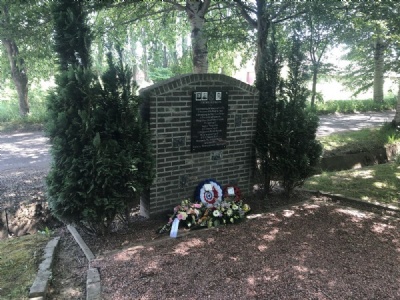Eben - Emael
Early in the morning of May 10, 1940, Germany launched its attack on Western Europe. The attack was called Case Yellow and was first planned to begin in the autumn of 1939, but had to be postponed several times due to bad weather. The attack itself was to take place on a broad front through the Benelux countries. A particularly important and strategic goal was the fortified fort at Eben-Emael and the three bridges that situated north of the fort. The fort was located along the newly constructed Albert canal that bordered Holland. Not that the Belgians saw Holland as a potential attacker, but more because they feared a German attack on Belgium through Holland.
The Fort was built on a rock formation called Caster on the outskirts of Eben-Emael. It was built between 1931 and 1935 and the triangular fort measured about 1000 x 700 meters and the cliff facing east was more or less vertical down towards the Albert canal making it impossible to attack the fort from the canal. The fort was surrounded by moats which made it difficult for an attacker to attack the fort by land. Inside the cliff, there were built three floors with space for an approximately 1200 man strong garrison. The fort also contained hospitals, dining rooms, fairs, lodges, storage rooms, all intertwined with connecting walkways. The fort’s armament consisted of everything from machine guns to anti-tank guns that could meet an attacker no matter what direction he came from. The fort was for its time extremely modern and was seen as more or less impregnable.
The Fort also had offensive firepower in form of cannons that could fire an attacker approaching from eastward from Holland. The cannons also gave the Belgians an opportunity to destroy the important bridges across the Albert canal in case these were threatened. The Bridges became a prime target for the germans ’cause they had to be taken intact. If not, the german’s risked that the attack would be crashed before it even started.
The task of securing and conquering the fort and bridges fell on German paratroopers under the leadership of Captain Walter Koch. Early in the morning of May 10, gliders landed undiscovered at the top of the fort. This was something that the Belgian designers had not counted on and the garrison was taken with total surprise. The paratroopers systematically advanced and only faced sporadic resistance from the defenders. All this with minimal losses. Around the same time as the fort was attacked, German gliders landed with paratroopers at three bridges north of the fort, Kanne, Vroenhoven and Veldweltz with the task of securing them intact.
At the last two bridges, the Belgian defenders were taken by the same surprise as at the fort and the bridges could be secured. In the event of a German attack, they had already been mined, but these charges could not be triggered before the defenders were captured. At Kanne, which was closest to the fort, the defenders had been warned of a German attack and the glider landed a little too far away, which meant that the important element of surprise was lost. The Belgian defenders therefore managed to blow up the bridge before surrendering to an overpowering enemy.
In just a few hours, the paratroopers had occupied and neutralized a strategic fort and secured two important bridges. The Germans were now tasked with holding and defending these until the german 18th army arrived, which they did on 11 may. For the Germans, the attack was a great military success. Of the approximately 500 paratroopers who participated in the attack on the fort and bridges, the Germans did not lose more than six men and about 20 were injured. The Belgians lost about 60 men while just over 1000 were captured. The German commander in the attack, Captain Walter Koch, was later personally rewarded by Adolf Hitler with the Knight Cross award.
Current status: Preserved with museum (2022).
Address: Rue du Fort, 4690 Bassenge.
Get there: Car.
Follow up in books: Jackson, Julian: The Fall of France: The Nazi Invasion of 1940 (2003).













When I visited the fort for the first time in 2008, opening hours were limited and access to the fort’s exterior was limited because it was military area. When I visited the fort in 2022, the opening hours were extended and the fort’s exterior is now accessible and you can therefore walk up the top of the fort and see where the German gliders landed. In a way, the top of the fort is at least as interesting as the inside of the fort. At the bridges at Veldwezelt, Vroenhoven and Kanne there are also monuments, bunkers and even a small museum (Vroenhoven).